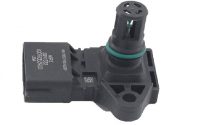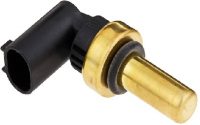Description for 150 Watt Amplifier Circuit
Amplifiers are the one of the most commonly used circuits or devices in electronics.These are the basic building blocks in wireless communication and broadcasting, and other audio system which is used to enhance the characteristics of the signal. An amplifier can be defined as, is an electronic device which increases the input signal. It increases the voltage, current or power of the input signal.
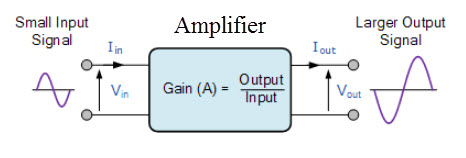
150 Watt Power Amplifier Circuit
Before going to discuss the concept of 150W power amplifier circuit lets know about the types of amplifiers, power amplifier circuit, concept of power amplifier and working of power amplifier.
Types of Amplifiers
Amplifiers are categorized into weak-signal amplifiers or power amplifiers.
Weak Amplifier
Weak signal amplifiers are used in wireless receivers, acoustic pickups, audio tape players, and CD players. A weak-signal amplifier is designed to deal with small input signals. Such amplifiers must generate minimal internal noise while increasing the value of signal voltage by a large factor. Field Effect Transistors (FET) are more efficient for such applications.
Power Amplifier
Power amplifiers are used in broadcast transmitters, wireless transmitters and high audio systems. Bipolar transistors are used for these applications. Power output and efficiency are mostly considered in power amplifications.
Power Amplifier Circuit
A power amplifier circuit is used to drive the loads like speakers with minimum output impedance. Speakers require high power at low impedance. Here the amplifier circuit is designed using push pull class AB configuration.
The principle behind the design of amplifier circuit is the different ways of biasing a Bipolar Junction Transistor (BJT). The electrical signal output of the microphone is low. So this low voltage signal is amplified to a sustainable level using the Common Emitter (CE) configuration of a BJT which is biased in class A mode. In this mode the output is an inverted amplified signal which is at low power. Two Darlington power transistors are arranged in a class AB configuration to amplify the power level of this signal. A transistor configured in class A mode is used to drive this transistor configuration.
Concept of Power Amplifier Circuit
The main aspects of the circuit are class AB amplifier and a class A voltage amplifier. A transistor biased in class AB mode produces an amplified output signal for one half of the input signal. Thus, class AB amplifier consists of two transistors wherein one conducts for one half of the input signal and another conducts for the second half of the input signal. In practical, class AB amplifier consists of diodes to provide biasing to the two transistors to eliminate crossover distortion. A transistor biased in class A mode produces an inverted input signal while having low efficiency.
Working of the Power Amplifier
There are different designs in power amplifiers for different requirements of 20W, 50W and 100W of RMS value. A power amplifier circuit consists of unique circuit to produce voltage and power gain. This consists of three amplification stages, namely
- Voltage amplification stage
- Driver stage
- Output stage
The following block diagram shows the amplification stages.

The following circuit diagram discusses the 150W power amplifier circuit.
This circuit uses TIP 142 and TIP 147 in Darlington combination to deliver 150W RMS to a 4Ω speaker. This complementary Darligton pair transistors can handle 5A current and 100V voltage.
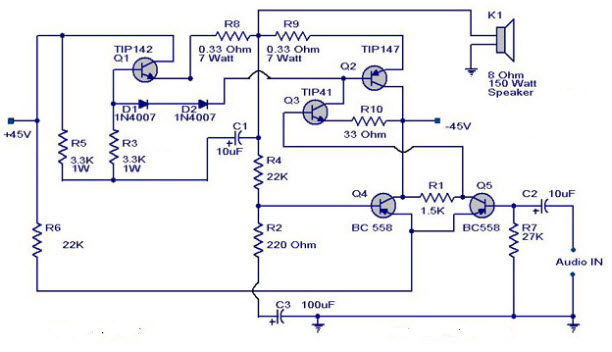
Two BC 558 transistors Q5 and Q4 are wired as pre-amplifier and TIP 142 and TIP 147 together with TIP41 are used for driving the speaker. This circuit is fed a power from the 5A dual power supply.
The pre-amplifier section of this circuit is based around transistor Q4 and Q5 which forms a differential amplifier. A differential amplifier reduces the noise and provides a means for applying negative feedback. Thus the overall performance of the circuit is improved. The input signal is applied to the base of Q4 from the junction of 0.33Ω resistor and 22KΩ resistor. A complementary class AB push pull stage is built around the Q1 and Q2 to drive the speaker. Diodes D1 and D2 biases the complementary pair and ensures the proper operation of class AB. Transistor Q3 drives the push pull pair and its base is directly coupled to the collector of transistor Q5.
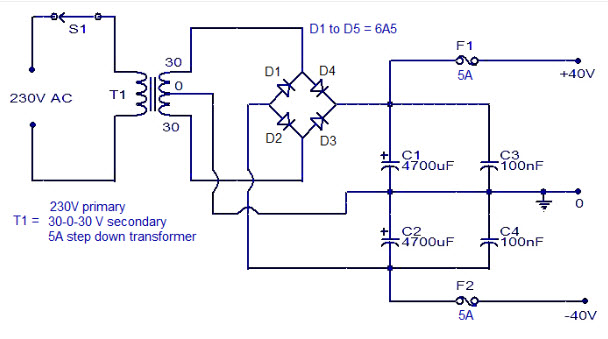
A +40/-40 unregulated dual supply is used for powering this amplifier circuit. This power supply is enough for powering one channel and for stereo applications twice the current ratings of the transformer, diodes and fuses. The circuit below is the dual power supply unit.
Applications of Power Amplifier Circuit
- This can be used to drive a speaker of low input impedance.
- This is also used to drive high power antennas for long range transmission.
Drawbacks
The use of BJTs cause more power dissipation. Thus, reducing the efficiency of the system.
This article includes the concepts about power amplifier circuits, its types and working, hope that you have got a better understanding of this concept. Furthermore, for any queries regarding this concept or electrical and electronics projects please give your feedback in the comment section below.


